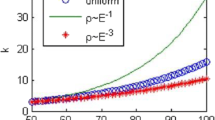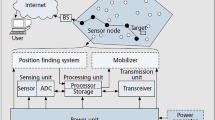Abstract
Hierarchical topology control is an efficient technique and commonly used in wireless sensor networks (WSNs). Complex network theory is used for depicting and investigating structures and functions of natural and artificial networks/systems. In this paper, we explore directed and weighted dynamics of hierarchical WSNs, based on complex network theory. Early work did not considerate edge directions and attribute of heterogeneous node. We present two dynamic evolution models, which consider link/communication directions in real WSNs, and two kinds of nodes: router node and normal node are introduced into two evolution models with directed weighted edges. Then we conduct theoretical analysis by using statistical physics approach. With numerical simulations, the results show that two models fit well with expect goals. The two models could be extended in some practical projects and have better effects than common un-weighted network model.






Similar content being viewed by others
References
Atmojo UD, Salcic Z, Wang KI, Park H (2015) System-level approach to the design of ambient intelligence systems based on wireless sensor and actuator networks. J Ambient Intel Humaniz Comput 6(2, SI):153–169
Barabási AL (2009) Scale-free networks: a decade and beyond. Science 325(5939):412–413
Barabási AL, Albert R (1999) Emergence of scaling in random networks. Science 297(5439):509–512
Barrat A, Barthelemy M, Vespignani A (2004) Modeling the evolution of weighted networks. Phys Rev E 70(6):1–12
Batrat A, Pastor-Satorras R, Barthelemy M, Vespignani A (2004) The architecture of complex weighted networks. In: Proceedings of the national academy of sciences of the United States of America, pp 3747–3752
Boccaletti S, Latora V, Moreno Y, Chavez M, Hwang D-U (2006) Complex networks: structure and dynamics. Phys Rep 424(4–5):175–308
Chen LJ, Chen DX, Li X, Cao JN (2007) Evolution of wireless sensor network. In: IEEE wireless communications and networking conference (WCNC’07), pp 3003–3007
Hassan MK, Hassan MZ, Pavel NI (2010) Scale-free network topology and multifractality in a weighted planar stochastic lattice. New J Phys 12:1–13
Hébert-Dufresne L, Allard A, Marceau V, Noel P-A, Dubé LJ (2011) Structural preferential attachment: network organization beyond the link. Phys Rev Lett 107(15):1–5
Holme P, Edling CR, Liljeros F (2004) Structure and time evolution of an internet dating community. Soc Netw 26(2):155–174
Jeong H, Mason SP, Barabasi AL, OItvai ZN (2001) Lethality and centrality in protein networks. Nature 411(6833):41–42
Jiang N (2014) Wdem: weighted dynamics and evolution models for energy-constrained wireless sensor networks. Phys A Stat Mech Appl 404:323–331
Jiang N, Chen H, Xiao X (2012) A local world evolving model for energy-constrained wireless sensor networks. Int J Distrib Sens Netw 1–9. ISSN 1550-1329. doi:10.1155/2012/542389
Jiang N, Li FY, Wan T, Liu LF (2014) Pdf: poisson dynamics in fitness evolution model for wireless sensor networks. J Ambient Intel Humaniz Comput 5(6):919–927
Jiang N, Xiao X, Liu L (2015) Localization scheme for wireless sensor networks based on “shortcut” constraint. Ad Hoc Sens Wirel Netw 26(1–4):1–19
Li SD, Li LX, Yang YX (2011) A local-world heterogeneous model of wireless sensor networks with node and link diversity. Phys A 390(6):1182–1191
Li W, Cai X (2004) Large-scale topological and dynamical properties of the internet. Phys Rev E 695(4):1–6
Li X, Chen GR (2003) A local-world evolving network model. Phys A 328(1–2):274–286
Liu Y, Yuan J, Shan XM, Ren Y, Ma ZX (2008) Self-determined mechanisms in complex networks. Phys A 387:2145–2154
Maslov S, Sneppen K, Zaliznyak A (2004) Detection of topological patterns in complex networks: correlation profile of the internet. Phys A 333:529–540
Pastor-Satorras R, Vespignani A (2004) Evolution and structure of the internet: a statistical physics approach. Cambridge University Press, Cambridge
Pastor-Satorras R, Vazquez A, Vespignani A (2001) Dynamical and correlation properties of the internet. Phys Rev Lett 87(25):1–4
Ravasz E, Somera AL, Mongru DA, Oltvai ZN, Barabasi A-L (2002) Hierarchical organization of modularity in metabolic networks. Science 297(5586):1551–1555
Serrano MA, Boguna M, Diaz-Guilera A (2005) Competition and adaptation in an internet evolution model. Phys Rev Lett 94(3):1–4
Serrano MA, Boguna M, Diaz-Guilera A (2006) Modeling the internet. Eur Phys J B 50(1–2):249–254
Shakkottai S, Fomenkov M, Koga R, Krioukov D, Claffy KC (2008) Evolution of the internet as-level ecosystem. Eur Phys J B 74(2):271–278
Stefancic H, Zlatic V (2005) Winner takes it all: strongest node rule for evolution of scale-free networks. Phys Rev E 72(3):1–6
Vazquez A, Pastor-Satorras R, Vespignani A (2002) Large-scale topological and dynamical properties of the internet. Phys Rev E 65(6):1–12
Wang XF, Chen GR (2003) Complex networks: small-world, scale-free and beyond. IEEE Circuits Syst Mag 3(1):6–20
Zeng H, Shi Y, Hou YT, Zhu RB, Lou W (2014) A novel mimo dof model for multi-hop networks. IEEE Netw 28(5):81–85
Zhu HL, Luo H, Peng HP, Li LX, Luo Q (2009) Complex networks-based energy-efficient evolution model for wireless sensor networks. Chaos Solitons Fractals 41(4):1828–1835
Acknowledgments
This work is supported by National Natural Science Foundation of China under Grant Nos. 41402290, 61462028 and 81460275; Major Project for Natural Science Foundation of Jiangxi Province of China under Grant No. 20152ACB21011; Key Technology Research; Development Program of Jiangxi Province of China under Grant No. 20151BBE50068; External Science and Technology Cooperation Project of Jiangxi Province of China under Grant No. 20151BDH80010.
Author information
Authors and Affiliations
Corresponding author
Rights and permissions
About this article
Cite this article
Jiang, N., Li, B., Chen, H. et al. DWDH: directed and weighted dynamics of hierarchical wireless sensor networks. J Ambient Intell Human Comput 7, 257–265 (2016). https://doi.org/10.1007/s12652-015-0326-3
Received:
Accepted:
Published:
Issue Date:
DOI: https://doi.org/10.1007/s12652-015-0326-3




